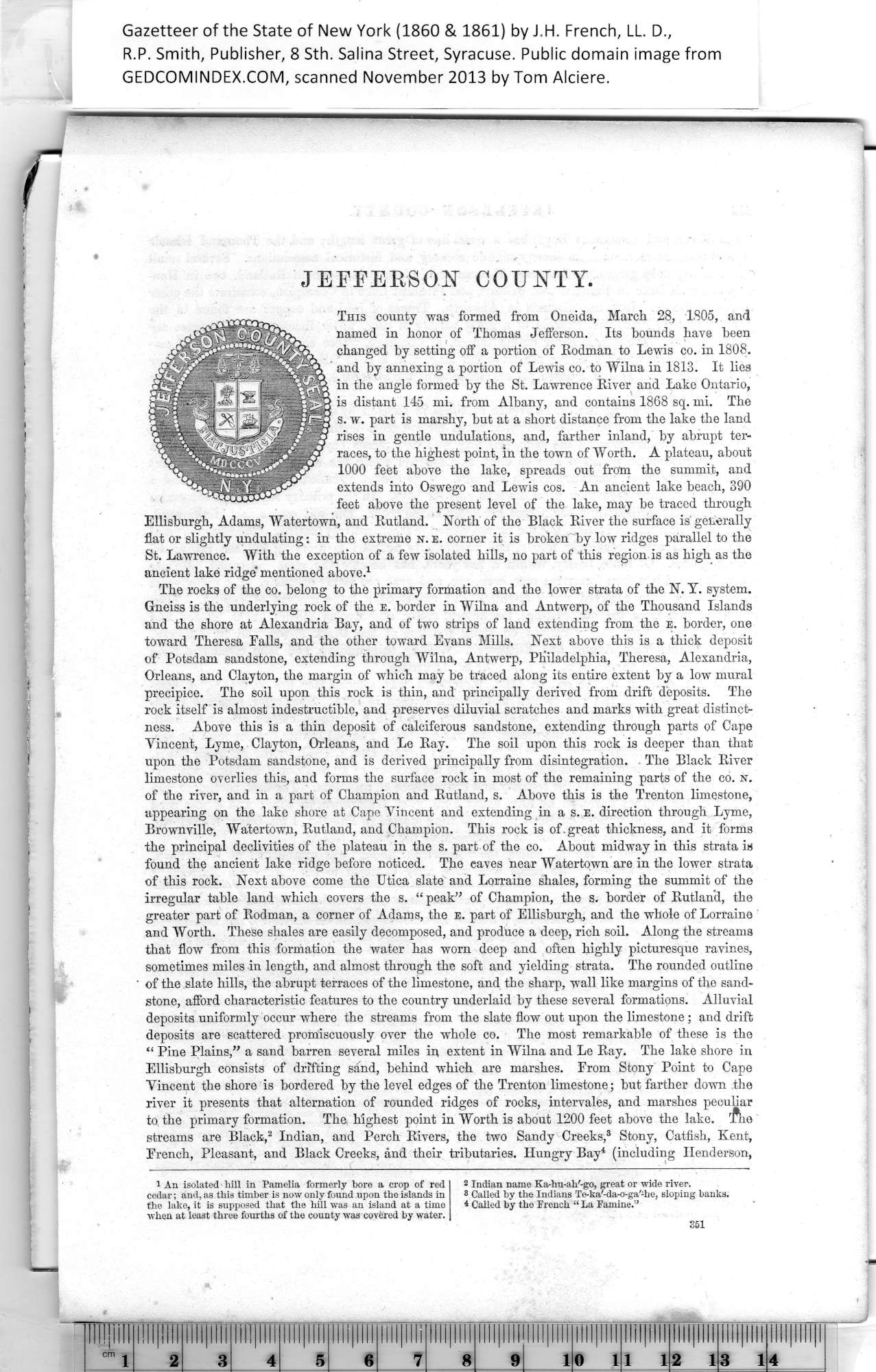|
JEFFERSON COUNTY.
This county was formed from Oneida, March 28, 1805, and
named in honor of Thomas Jefferson. Its bounds have been
changed by setting off a portion of Hodman to Lewis co. in 1808.
and by annexing a portion of Lewis co. to Wilna in 1813. It lies
in the angle formed by the St. Lawrence Eiver and Lake Ontario,
is distant 145 mi. from Albany, and contains 1868 sq. mi. The
s. w. part is marshy, but at a short distance from the lake the land
rises in gentle undulations, and, farther inland, by abrupt ter¬
races, to the highest point, in the town of Worth. A plateau, about
1000 feet above the lake, spreads out from the summit, and
extends into Oswego and Lewis cos. An ancient lake beach, 390
feet above the present level of the lake, may be traced through
Ellisburgh, Adams, Watertown, and Kutland. North of the Black Eiver the surface is generally
flat or slightly undulating: in the extreme n.e. corner it is broken by low ridges parallel to the
St. Lawrence. With the exception of a few isolated hills, no part of this region is as high as the
ancient lake ridge" mentioned above.1
The rocks of the co. belong to the primary formation and the lower strata of the N. Y. system.
Gneiss is the underlying rock of the e. border in Wilna and Antwerp, of the Thousand Islands
and the shore at Alexandria Bay, and of two strips of land extending from the e. border, one
toward Theresa Falls, and the other toward Evans Mills. Next above this is a thick deposit
of Potsdam sandstone, extending through Wilna, Antwerp, Philadelphia, Theresa, Alexandria,
Orleans, and Clayton, the margin of which may be traced along its entire extent by a low mural
precipice. The soil upon this rock is thin, and principally derived from drift deposits. The
rock itself is almost indestructible, and preserves diluvial scratches and marks with great distinct¬
ness. Above this is a thin deposit of calciferous sandstone, extending through parts of Cape
Vincent, Lyme, Clayton, Orleans, and Le Eay. The soil upon this rock is deeper than that
upon the Potsdam sandstone, and is derived principally from disintegration. The Black Eiver
limestone overlies this, and forms the surface rock in most of the remaining parts of the co. n.
of the river, and in a part of Champion and Eutland, s. Above this is the Trenton limestone,
appearing on the lake shore at Cape Vincent and extending in a s.e. direction through Lyme,
Brownville, Watertown, Eutland, and Champion. This rock is of.great thickness, and it forms
the principal declivities of the plateau in the s. part of the co. About midway in this strata is
found the ancient lake ridge before noticed. The caves near Watertown are in the lower strata
of this rock. Next above come the Utica slate and Lorraine shales, forming the summit of the
irregular table land which covers the s. “peak” of Champion, the s. border of Eutland, the
greater part of Eodman, a corner of Adams, the e. part of Ellisburgh, and the whole of Lorraine
and Worth. These shales are easily decomposed, and produce a deep, rich soil. Along the streams
that flow from this formation the water has worn deep and often highly picturesque ravines,
sometimes miles in length, and almost through the soft and yielding strata. The rounded outline
of the slate hills, the abrupt terraces of the limestone, and the sharp, wall like margins of the sand¬
stone, afford characteristic features to the country underlaid by these several formations. Alluvial
deposits uniformly occur where the streams from the slate flow out upon the limestone; and drift
deposits are scattered promiscuously over the whole co. The most remarkable of these is the
“ Pine Plains,” a sand barren several miles in extent in Wilna and Le Eay. The lake shore in
Ellisburgh consists of drifting sand, behind which are marshes. From Stony Point to Cape
Vincent the shore is bordered by the level edges of the Trenton limestone; but farther down the
river it presents that alternation of rounded ridges of rocks, intervales, and marshes peculiar
to the primary formation. The highest point in Worth is about 1200 feet above the lake. £he
streams are Black,2 Indian, and Perch Eivers, the two Sandy Creeks,3 Stony, Catfish, Kent,
French, Pleasant, and Black Creeks, and their tributaries. Hungry Bay4 (including Henderson,
|
2 Indian name Ka-hu-ah'-go, great or wide river.
8 Called by the Indians Te-ka'-da-o-gfi'-he, sloping banks.
* Called by the French “ La Famine.” |
S51
1
An isolated hill in Pamelia formerly hore a crop of red
cedar; and, as this timber is now only found upon the islands in
the lake, it is supposed that the hill was an island at a time
when at least three fourths of the county was covered by water.
|
